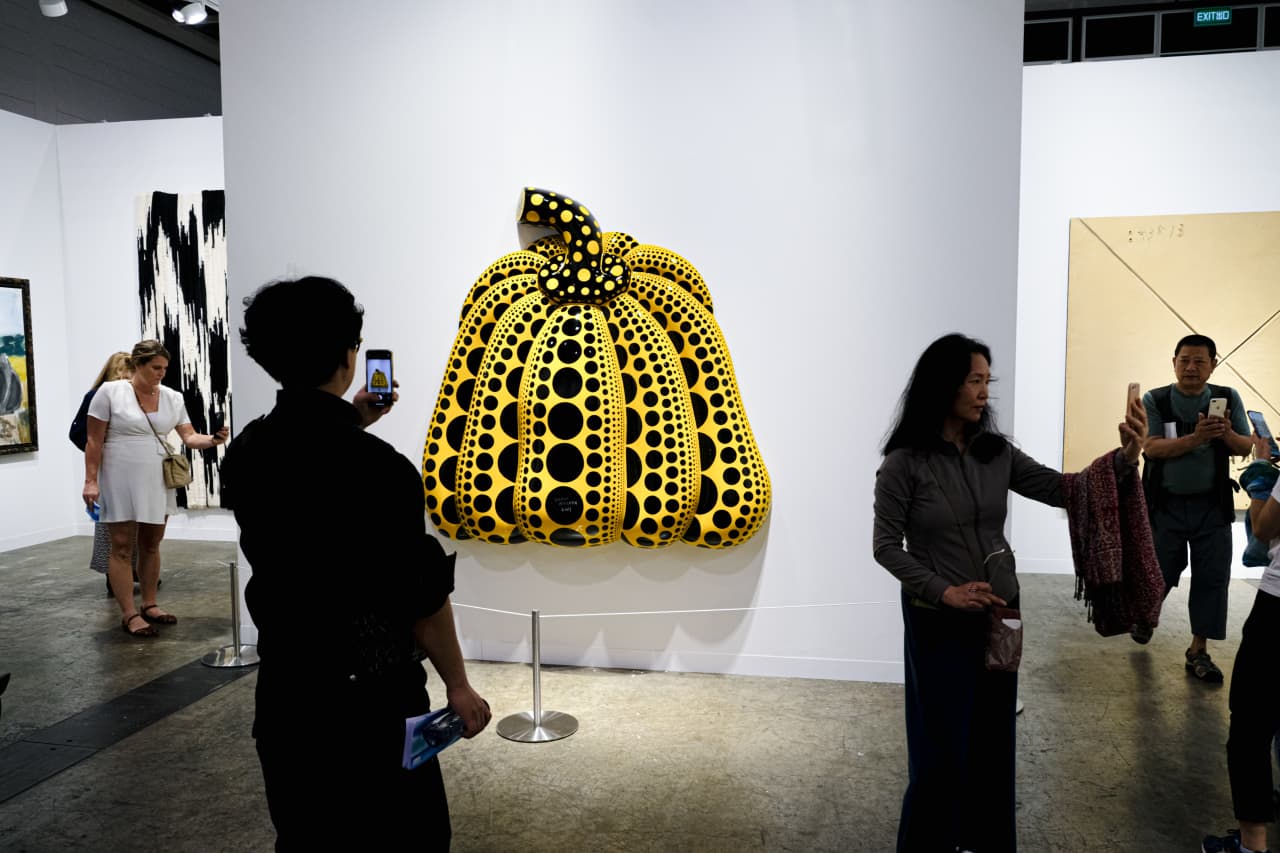Yayoi Kusama Tops 2023 List of 21st-Century Artists
Artworks by Yayoi Kusama collectively sold for nearly US$81 million last year at the major global auction houses, making her the top-selling 21st-century contemporary artist, according to the Hiscox Artist Top 100 report.
The boost in sales for Kusama’s works pushed David Hockney, the previous year’s top-selling artist, to second place. Hockney’s art garnered US$50.3 million in sales last year, down from US$74.7 million in 2022, said Hiscox, a London-based specialty insurer.
The second annual ranking, compiled with research and analysis from London-based ArtTactic, also showed Kusama’s No. 1 ranking was consistent with a strong showing by women artists overall last year. Joining Kusama among the top five last year was Cecily Brown, who ranked fourth with US$31.7 million in sales.
Yoshitomo Nara, ranked third with sales of US$36 million and George Condo ranked fifth with sales of US$29.5 million.
Total sales of contemporary art made after the year 2000 fell 17% to US$955 million last year from US$1.5 billion in 2022, according to the report. Though sales of contemporary art by women fell 8% to US$306 million, the number of works sold rose 21%. And sales by their male peers fell a much sharper 20%, the report said.
“The market for female artists has been much more resilient than that for male artists,” the report said.
The results go beyond ultra-contemporary art. Earlier this year, ArtTactic reported that overall sales of art by women at the major auction houses hit a record US$825.8 million last year, up 7% from a year earlier.
Another mark of progress: Art by women comprised 32% of 21st-century art auction sales last year, up from 29% in 2022, as the number of women artists behind these sales continued to climb. There were 728 women artists represented last year, up 179% from 2019, the report said.
“Contemporary female artists have always been undervalued and underrepresented,” Robert Read , head of art and private clients at Hiscox said in a news release. “Meaningful progress has been made in recent years, as the market gradually begins to recognise the importance and value of their work, but we are still some way from parity.”
Following Kusama and Brown, the top female artists by sales value were Julie Mehretu, with sales of US$21.4 million; Jadé Fadojutimi, with sales of US$8.5 million; and Jenny Saville, with sales of US$7.8 million.
The Hiscox report just examined the auction market for works created in the 21st century and sold at Christie’s, Phillips, and Sotheby’s. This segment was stronger than much of the art market last year, with sales still 26% above pre-pandemic levels. Sales of art made before 2000 have fallen 22% since 2019, the report said.
This segment of the market is also making up a larger share of all post-war and contemporary art sold at auctions, reaching 70% last year from 63% a year earlier.
The Hiscox report was consistent with other analyses of the art market last year that found large-ticket sales, over US$1 million, declined in favor of sales of works with price tags of US$50,000 or less.
Within the 21st-century art category, the number of lower-priced works sold gained 25% while the number sold above US$1 million fell by 12%. The trend is backed by a near doubling in the number of artists making 21st-century works that end up at auction since 2019, the report said.
The benefits of so-called flipping—or the practice of selling art made by young artists within two years of their creation—fell dramatically, bringing in US$39 million in sales last year from US$67 million in 2022. That’s despite the number of lots with this newly made art at 662 was about the same as the previous year.
Though Kusama is 95 years old, 41% of those making 21st-century art are under age 45, unsurprisingly. Leading this group of younger artists last year was: Nicolas Party, whose works sold for US$20.2 million; the late Matthew Wong, whose works sold for US$16.5 million; Fadojutimi; Caroline Walker, whose works sold for US$7.5 million; and Dmitri Cherniak, whose works sold for US$6.7 million.
This stylish family home combines a classic palette and finishes with a flexible floorplan
Just 55 minutes from Sydney, make this your creative getaway located in the majestic Hawkesbury region.
Continued stagflation and cost of living pressures are causing couples to think twice about starting a family, new data has revealed, with long term impacts expected
Australia is in the midst of a ‘baby recession’ with preliminary estimates showing the number of births in 2023 fell by more than four percent to the lowest level since 2006, according to KPMG. The consultancy firm says this reflects the impact of cost-of-living pressures on the feasibility of younger Australians starting a family.
KPMG estimates that 289,100 babies were born in 2023. This compares to 300,684 babies in 2022 and 309,996 in 2021, according to the Australian Bureau of Statistics (ABS). KPMG urban economist Terry Rawnsley said weak economic growth often leads to a reduced number of births. In 2023, ABS data shows gross domestic product (GDP) fell to 1.5 percent. Despite the population growing by 2.5 percent in 2023, GDP on a per capita basis went into negative territory, down one percent over the 12 months.
“Birth rates provide insight into long-term population growth as well as the current confidence of Australian families,” said Mr Rawnsley. “We haven’t seen such a sharp drop in births in Australia since the period of economic stagflation in the 1970s, which coincided with the initial widespread adoption of the contraceptive pill.”
Mr Rawnsley said many Australian couples delayed starting a family while the pandemic played out in 2020. The number of births fell from 305,832 in 2019 to 294,369 in 2020. Then in 2021, strong employment and vast amounts of stimulus money, along with high household savings due to lockdowns, gave couples better financial means to have a baby. This led to a rebound in births.
However, the re-opening of the global economy in 2022 led to soaring inflation. By the start of 2023, the Australian consumer price index (CPI) had risen to its highest level since 1990 at 7.8 percent per annum. By that stage, the Reserve Bank had already commenced an aggressive rate-hiking strategy to fight inflation and had raised the cash rate every month between May and December 2022.
Five more rate hikes during 2023 put further pressure on couples with mortgages and put the brakes on family formation. “This combination of the pandemic and rapid economic changes explains the spike and subsequent sharp decline in birth rates we have observed over the past four years,” Mr Rawnsley said.
The impact of high costs of living on couples’ decision to have a baby is highlighted in births data for the capital cities. KPMG estimates there were 60,860 births in Sydney in 2023, down 8.6 percent from 2019. There were 56,270 births in Melbourne, down 7.3 percent. In Perth, there were 25,020 births, down 6 percent, while in Brisbane there were 30,250 births, down 4.3 percent. Canberra was the only capital city where there was no fall in the number of births in 2023 compared to 2019.
“CPI growth in Canberra has been slightly subdued compared to that in other major cities, and the economic outlook has remained strong,” Mr Rawnsley said. “This means families have not been hurting as much as those in other capital cities, and in turn, we’ve seen a stabilisation of births in the ACT.”
This stylish family home combines a classic palette and finishes with a flexible floorplan
Just 55 minutes from Sydney, make this your creative getaway located in the majestic Hawkesbury region.

















